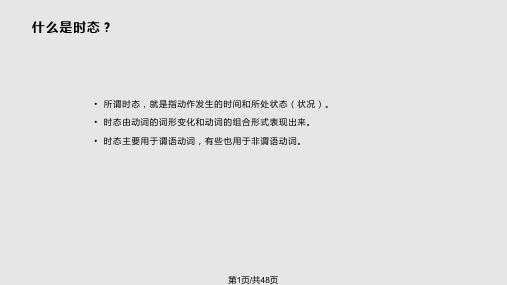八种常见动词时态讲解(1)PPT课件
合集下载
初中英语-中考时态复习-公开课精品课件-八大时态完整版

结构:do does 标志语:
often,always,usually,sometimes, every day/week/month/year...
习惯活动 现在情况 客观事实 主将从现
I get up at six every morning. They are very busy. He needs help.
当主语不是第三人称单数时:
• 肯定句 :主语+动词原形+其它 • 否定句 :主语+don't+动词原形+其它 • 一般疑问句: Do+主语+动词原形+其它 • 特殊疑问句:特殊疑问词+一般疑问句 注意★:句式结构错则全句都错。 • 谓语动词的形式:do/does • 助动词的形式:don't(do not)/doesn't(does not)
英语时态复习
初中阶段应掌握的时态共有八种:
一般现在时、一般过去时、一般将来时 现在进行时、现在完成时 过去进行时、过去将来时、过去完成时
在英语语法中,"时"指动作发生的时间,"态"指动作的样子和状态。
一般现在时 Present Simple
What does he/she often do? What do they often do?
肯定式 I work. You work. We work. They work. He works.
疑问式
否定式
疑问否定式
Do I work?
I don't work.
Don't I work?
Do you work? You don't work. Don't you work?
often,always,usually,sometimes, every day/week/month/year...
习惯活动 现在情况 客观事实 主将从现
I get up at six every morning. They are very busy. He needs help.
当主语不是第三人称单数时:
• 肯定句 :主语+动词原形+其它 • 否定句 :主语+don't+动词原形+其它 • 一般疑问句: Do+主语+动词原形+其它 • 特殊疑问句:特殊疑问词+一般疑问句 注意★:句式结构错则全句都错。 • 谓语动词的形式:do/does • 助动词的形式:don't(do not)/doesn't(does not)
英语时态复习
初中阶段应掌握的时态共有八种:
一般现在时、一般过去时、一般将来时 现在进行时、现在完成时 过去进行时、过去将来时、过去完成时
在英语语法中,"时"指动作发生的时间,"态"指动作的样子和状态。
一般现在时 Present Simple
What does he/she often do? What do they often do?
肯定式 I work. You work. We work. They work. He works.
疑问式
否定式
疑问否定式
Do I work?
I don't work.
Don't I work?
Do you work? You don't work. Don't you work?
动词时态PPT课件

It can’t be Jim. he has gone to town . John knows the way well. He has been to the city before .
第25页/共48页
D. 瞬间动词和持续性动词 1. 他来北京五天了。
√ He has been in Beijing for 5
过去将来完成时 现在完成进行时
过去完成进行时 将来完成进行时
过去将来完成进行时
第14页/共48页
三、时态的用法
1、一般现在时:是表述现在或经 常性的动作,状态.
A. 表述现阶段或经常性的动作,状态。 他每天骑自行车上学。
He goes to school by bike every day. B. 表客观真理
days.
× He has come to Beijing for 5 days.
第26页/共48页
D. 瞬间动词和持续性动词
2. 小明入团三年了。
Xiao Ming has been in the League for 3 years.
√
√ Xiao Ming has been a League
member for 3 years
Xiao Ming has joined the League for three years.
×
第27页/共48页
D. 瞬间动词和持续性动词
3. 这本书他买了一年了。
He has had this book
√
for a year.
× He has bought this book
练习。
完 成
先结构,
后改1,
完成 和加1
进行
第25页/共48页
D. 瞬间动词和持续性动词 1. 他来北京五天了。
√ He has been in Beijing for 5
过去将来完成时 现在完成进行时
过去完成进行时 将来完成进行时
过去将来完成进行时
第14页/共48页
三、时态的用法
1、一般现在时:是表述现在或经 常性的动作,状态.
A. 表述现阶段或经常性的动作,状态。 他每天骑自行车上学。
He goes to school by bike every day. B. 表客观真理
days.
× He has come to Beijing for 5 days.
第26页/共48页
D. 瞬间动词和持续性动词
2. 小明入团三年了。
Xiao Ming has been in the League for 3 years.
√
√ Xiao Ming has been a League
member for 3 years
Xiao Ming has joined the League for three years.
×
第27页/共48页
D. 瞬间动词和持续性动词
3. 这本书他买了一年了。
He has had this book
√
for a year.
× He has bought this book
练习。
完 成
先结构,
后改1,
完成 和加1
进行
英语时态8种基本时态讲解.ppt课件

4)动词过去式变化规则。 a)一般情况下的词加-ed. work---worked call----called b)以不发音的字母e结尾的单词直接加-d . live----lived change----changed smoke----smoked die----died graduate----graduated drive----drove
8.过去完成时 表示动作发生在过去某一时间之前已经完成的动作或状态, 强调“过去的过去”, 常与 by the time, by the end of…,before , by 等引导时间的状语连用。
基本结构 主语+ had + 动词过去分词 + 其他成分 When I got to the cinema yesterday the film had begun already. He had learned English before he came here.
现在完成时与一般过去时的区别: 1)现在完成时侧重于对现在的影响;而一般过去时侧重于某一动作发生在过去某个时间或某段时间。即现在完成时侧重于现在的结果,而一般过去时侧重于动作发生的时间。例如:
I have seen the film. 我看过这部电影。(现在我仍记得电影的内容) I saw the film three days ago. 三天前我看了这部电影。(强调是三天前,而不是别的什么时候看的电影)
be going to含有“打算,准备”的意思,而will则没有这个意思, She is going to lend us her book. He will be here in half an hour.
be about to+V.原形(意为马上做某事,在时间上指最近的将来) I am about to leave school. 不能与表示时间的副词连用。 They are about to set out.(√) They are about to set,变y为i加-ed. study----studied carry----carried cry----cried try----tried d)以元音字母+y结尾的单词直接加-ed. play----played stay----stayed
8.过去完成时 表示动作发生在过去某一时间之前已经完成的动作或状态, 强调“过去的过去”, 常与 by the time, by the end of…,before , by 等引导时间的状语连用。
基本结构 主语+ had + 动词过去分词 + 其他成分 When I got to the cinema yesterday the film had begun already. He had learned English before he came here.
现在完成时与一般过去时的区别: 1)现在完成时侧重于对现在的影响;而一般过去时侧重于某一动作发生在过去某个时间或某段时间。即现在完成时侧重于现在的结果,而一般过去时侧重于动作发生的时间。例如:
I have seen the film. 我看过这部电影。(现在我仍记得电影的内容) I saw the film three days ago. 三天前我看了这部电影。(强调是三天前,而不是别的什么时候看的电影)
be going to含有“打算,准备”的意思,而will则没有这个意思, She is going to lend us her book. He will be here in half an hour.
be about to+V.原形(意为马上做某事,在时间上指最近的将来) I am about to leave school. 不能与表示时间的副词连用。 They are about to set out.(√) They are about to set,变y为i加-ed. study----studied carry----carried cry----cried try----tried d)以元音字母+y结尾的单词直接加-ed. play----played stay----stayed
中考英语专题 --八种常见动词时态讲解(共49张PPT)

二、一般过去时
1.一般过去时的结构:
主语+动词过去式+其它
I did my homework yesterday.
(did就是do的过去式) 否定构成:didn’t+动原 一般疑问构成及简答举例:Did+主语+动原+其它? 特殊疑问句举例:What did he do yesterday? When did he get up this morning?
火车明天上午六点开。
6)在复合句中,当主句是一般将来时,时间状语 从句或条件状语从句的谓语动词只能用一般现在 时来表示将来。 例如: I'll tell him the news when he comes back. 他 回来时,我将告诉他这个消息。
If you take the job , they will talk with you in greater details. 如果你接受这份工作,他们将和你谈谈细节。
I do my homework every day.
1.改为一般疑问句并回答。 Do you do your homework every day? Yes, I do./No, I don't. 2.改为否定句。 I don't do my homework every day.
Jim does his homework every day. 1.改为一般疑问句并回答。 Does Jim do his homework every day? Yes, he does./No, he doesn't. 2.改为否定句。 Jim doesn't do his homework every day.
动词时态(1)一般时态的构成与用法+课件-2025届高三上学期英语一轮复习专项

一般过去时的用法
② 一般过去时的特殊用法
b. 在口语中,一般过去时往往显示委婉客气。
I wondered if you could give me a hand. 我想请你帮个忙。 Might I come and see you tonight? 我想今晚来看你,好吗?
一般现在时和一般过去时的比较
一般将来时的用法
③表示同意或答应做某事
That bag looks heavy. I'll help you with it. 这个包看起来很重,我来帮你提。 I won't tell anyone what happened, I promise. 我保证不告诉别人所发生的事。
一般将来时的用法
一般将来时的用法
①表示将要发生的动作或存在的状态
I shall be free this afternoon. 我今天下午有空。 There'll be no chemistry classes tomorrow. 明天没有化学课。 They will probably go to Shanghai for their holiday. 他们可能去上海度假。
高中英语动词时态精讲(1)
一般时态的构成与用法
英语中的现在时
在英语中,不同时间发生的动作或存在的状态,要用 不同的动词形式来表示,这就叫做动词的时态。
一般时包括一般现在时、一般过去时、一般将来时和 一般过去将来时。
目录
01
ቤተ መጻሕፍቲ ባይዱ
02
03
04
一般现在时 一般过去时 一般将来时 一般过去将来时
01 一般现在时
一般过去时的用法
① 一般过去时的基本用法
八大时态讲解(共26张PPT)

He is going to buy her some flowers.
0 一般过去将来时:
He was sixty-eight. In two years he would be seventy.
I knew you would agree.
0 现在英进行语时的: 动词时态(进行) What are you doing?
算;
如:I am going to listen to music. (我打算听音乐) will /shall 表示未事先思考或为计划过的意图
如:It will be Christmas soon .(很快就圣诞节了)
4. 现在进行时态( The Present Continuous Tense )
5、我们离开广州六年了。
We have left Guangzhou for 6 years . ×
We have been away from Guangzhou for 6
years .
3.常见句型
1) 主句(现在完成时)+since 从句(一般过去时).
2) It is +一段时间+ since 从句(一般过去时).
has gone to
He said had seen this morning, …ago, etc
that he _________the film many 如果明天不下雨,我们将去野营。
He has borrowed the pen for three days .
times. 现在进行时态( The Present Continuous Tense )
was /were going to +动词原形
0 一般过去将来时:
He was sixty-eight. In two years he would be seventy.
I knew you would agree.
0 现在英进行语时的: 动词时态(进行) What are you doing?
算;
如:I am going to listen to music. (我打算听音乐) will /shall 表示未事先思考或为计划过的意图
如:It will be Christmas soon .(很快就圣诞节了)
4. 现在进行时态( The Present Continuous Tense )
5、我们离开广州六年了。
We have left Guangzhou for 6 years . ×
We have been away from Guangzhou for 6
years .
3.常见句型
1) 主句(现在完成时)+since 从句(一般过去时).
2) It is +一段时间+ since 从句(一般过去时).
has gone to
He said had seen this morning, …ago, etc
that he _________the film many 如果明天不下雨,我们将去野营。
He has borrowed the pen for three days .
times. 现在进行时态( The Present Continuous Tense )
was /were going to +动词原形
高中英语语法:动词的时态课件

二、一般过去时
(2)语境中的一般过去时,往往表示“刚才,在过去”之意,暗 示现在“已不再这样”。 Oh,how nice of you! I never thought you were going to bring me a gift.噢,你真是太好了!我没想到你会给我送礼物。 I didn’t notice where I was going.我当时没有注意到正往哪儿走。 Oh, it’s you, Mary. I didn’t know you would come.噢,是你啊,玛 丽,我不知道你会来。 (3)在时间和条件状语从句中,代替过去将来时。 Mary said as soon as she arrived there, she would ring me up.玛丽说 她一到达那里就给我打电话。
read reads读
write writes写
become becomes变成
know knows知道
一、一般现在时
(2)以字母s,x, ch, sh,o结尾的单词在词尾加-es。
watch watches观看
do does做
guess guesses 猜测
finish finishes完成
(3)以“辅音字母+y”结尾的动词,先变y为i,再加-es。
动词的时态综述
英语动词的时态变化共有一般、完成、进 行和完成进行4种形式,每种形式又包括现在、 过去、将来和过去将来4个时间,共组合成16 种时态形式。 高中英语课程标准要求同学们掌握的时态只有 8种:一般现在时、一般过去时、一般将来时、 现在进行时、过去进行时、现在完成时、过去 完成时、过去将来时。
stir
stirred搅拌
planΒιβλιοθήκη planned计划二、一般过去时
初中英语语法—时态(28张) PPT课件 图文

(4)现在完成时与表示一段时间的for短语、since短语或从句等 时,应注意句中的谓语动词须是延续性的,而不能是非延续性动词,如 come→be here,go→be there,die→be dead,borrow→keep,buy→h ,join→be in,leave→be away,begin to study→study等。
6.过去进行时
(1)概念:表示过去某一时刻或某一时间段内正在进行的动作。 (2)构成形式:was/were+动词的-ing形式 ①表示往返、位移的动词的过去进行时常可用来表示过去将来时
时态 We wanted to tell her that the train was_leaving an hour later.
1.一般现在时
基本用法: (1)表示经常性、习惯性的动作; He always helps others. 他总是帮助别人。
时态 (2)表示现在的情况或状态;
He is a teacher. 他是个老师。 (3)表示客观事实和普遍真理。 The sun rises in the east. 太阳从东边升起。 构成形式:am/is/are或实义动词的原形(主语是第三人称单数时,动 词要用第三人称单数形式)。
时态 (2)构成形式:have/has+动词的过去分词。
(3)与现在完成时连用的时间状语有for a long time,recently,yet, lately,ever,never,already,since,by this time,before,just,in t past/last few years,since+过去的时间点,since+时间段+ago,since +从句(一般过去时)。
表示感觉的动词。如:see,hear等。 表示喜欢或厌恶的动词。如:like,love等。 表示希望的动词。如:want,would like等。
动词的时态与语态共67张PPT

was/were going to do 或 would do
the next day等
专题9 动词的时态与语态3
时态 现在进行时 过去进行时
现在完成时
过去完成时
结构 am/is/are doing was/were doing
has/have done
had done
常连用的时间状语
now, these days等 at this time yesterday, at that time, when引导的时间 状语从句等 already, yet, ever, never, so far, for three days, since two days ago等 before, when引导的时 间状语从句, by+过 去时间
结构 am/is/are+过去分词
was/were+过去分词 will be或is/are going to be+过去分词 has/have been + 过去分词
情态动词+be+ 过去分词
示例
All these things are made by machines.
This book was written by Lu Xun.
专题9 动词的时态与语6态
4.在现在完成时的句子中,如果有持续的时间状语,要把非延续性动词变为 延续性动词。如: I have had the book for two days. 这本书我已经买了两天了。(用had,而不用bought) How long may I keep the book? 这本书我可以借多长时间?(用keep,而不用borrow)
The meeting took place in a beautiful city. 会议在一座美丽的城市举行。 A fire broke out during the night.
动词PPT课件

被动语态的构成
be动词+动词的过去分词 。例如:The book was written by him.(这本书 是他写的。)
03
动词不定式与动名词
不定式概念及形式
概念
不定式是动词的一种非谓语形式,表 示一种未完成的或将来的动作,由 “to + 动词原形”构成。
形式
不定式有一般式(to do)、完成式( to have done)和进行式(to be doing)三种形式,分别表示不同的 时间概念。
情态动词没有人称和数的变化 ,但有些情态动词有过去式的 变化。
can/could, may/might, must等情态动词用法
can/could 表示能力、可能性、允许或请求。例如
I can swim.(我会游泳。)Could you help me?(你能帮我吗?)
may/might 表示允许、可能或祝愿。例如
虚拟语气是一种特殊的动词形式,用来表示说话人的主观愿望、假设或建议等,而不是客观 事实。
虚拟语气的基本形式包括与现在事实相反的虚拟、与过去事实相反的虚拟和与将来事实相反 的虚拟。
虚拟语气的形式包括基本形式和倒装形式,其中倒装形式用于省略if的条件句中。例如:If I were you, I would go.(如果我是你,我会去的。)Had you come yesterday, you would have seen him.(如果你昨天来的话,你就会见到他了。)
walked to school yesterday.( 她昨天步行去学校。)
将来时
表示将来某个时间将要发生的动 作或存在的状态。例如:They will visit their grandparents next week.(他们下周将去看望
【精】初中英语八种时态PPT全面版

——Oh•, I’m(terri朝bly阳sor区ry.一模)——Have you seen Mr. Smith?
since+时• 间点—(—twYo eo’scl.ocLko, Aoukg,uhste20_0_3_,等_)__;__ his bike over there.
will He
prelatuy•srn(plAaDy..)
• C. writes…is writing
D. writes… writes
• ( 崇文区二模)Don’t turn off the radio. I _______ to the news.
——I’m• an eAng.inleisetre. n B. have listened C. listened D. am listening
I am st•udyin(g. 宣武区一模)——Do you think John will help me move the piano?
助现ret动在ur词 完ne说成••d 明时C该是—A. 谓初.—w语中rY是英itoe属语u于中’d现最bB在重e. 时要twte范也rrit围最en。难sot掌a握sCk的. 一hisi个mw时.rHi态tien,g_同_时_也_D_是._中w_r考_o_英te_语a中c一o个m最p重os要it的io时n.态考点.
• All things are difficult before they are easy. 凡事总是由难 而易。
• Shanghai lies in the east of China.上海位于中国东部。 • The teacher told us yesterday that December 25 is
• 2.用法 • a. 表示经常发生的动作或现阶段的习惯性行为,常与时
英语八大时态PPT课件(详细版)

时态
A
知识导航
种类
一般现在时 一般过去时 一般将来时 现在进行时 现在完成时 过去进行时 过去完成时 过去将来时
构成
do/does did will/shall+动词原形 am/is/are + doing have/has+过去分词 was/were + doing had+过去分词 would/should+动词原 形
A
4
※表示主语所具有的特征、性格、 能力、状态等
She is a middle school student. She looks a little worried. ※某些以here/there开头的句子 中,用一般现在时表正发生的动 作
Here comes the bus.
A
5
※表示将来发生的、时刻表上不改变的事 The train leaves Hunan at five o’clock. ※特殊情况 在时间状语从句和条件状语从句中,若主 句用一般将来时,则从句用一般现在代替 将来。(主将从现)
A
21
四、一般将来时
1、构成 一般将来时态由
“will/shall+动词原形”构成,me to ask Mary for help.
A
22
2、其他表示
※be going to +动词原形:表示 说话人主观的打算或预测。 I am going to look for a job here. It is going to be a fine day for camping tomorrow.
【小试牛刀】 他们昨天这个时候正在吃晚餐。
They were having dinner this time yesterday.
A
知识导航
种类
一般现在时 一般过去时 一般将来时 现在进行时 现在完成时 过去进行时 过去完成时 过去将来时
构成
do/does did will/shall+动词原形 am/is/are + doing have/has+过去分词 was/were + doing had+过去分词 would/should+动词原 形
A
4
※表示主语所具有的特征、性格、 能力、状态等
She is a middle school student. She looks a little worried. ※某些以here/there开头的句子 中,用一般现在时表正发生的动 作
Here comes the bus.
A
5
※表示将来发生的、时刻表上不改变的事 The train leaves Hunan at five o’clock. ※特殊情况 在时间状语从句和条件状语从句中,若主 句用一般将来时,则从句用一般现在代替 将来。(主将从现)
A
21
四、一般将来时
1、构成 一般将来时态由
“will/shall+动词原形”构成,me to ask Mary for help.
A
22
2、其他表示
※be going to +动词原形:表示 说话人主观的打算或预测。 I am going to look for a job here. It is going to be a fine day for camping tomorrow.
【小试牛刀】 他们昨天这个时候正在吃晚餐。
They were having dinner this time yesterday.
初中英语八大时态讲解_图文

2 have been to+地点,表示“去过某地”
。(人已回) I have been to Europe. (I am not in Europe now.)
3 have been in+地点+时间段,表示“在/ 来某地多久”。
I have been in Europe for three weeks. (I am now still in Europe .)
go there get home open close get to know borrow buy
be there be home be open be closed know keep have
1.The film began 5 The film_h_a_s b_e_en_o_n__ for 5
• 9.They got to know 10 They_h_av_e_k_n_o_w_n__since 10
years ago.
years ago.
• 10.I borrowed the book a I_h_a_v_e _k_e_p_t _the book for a
week ago.
week.
二、一般过去时
1.用法:过去的动作或状态。
2.标志词:
yesterday, the day before yesterday,
three days ago, last night/week/month…,in the past;just
now=a moment ago
例题
Li Ming didn’t understand what American people
4.He joined the club 3 He__h_as_b_e_en_i_n__the club for
初中英语动词【时态语态】PPT课件

I __w_i_ll_w_r_it_e__to__ Jim when heg_e_ts____ there. 当吉姆到达那里时,我将给他写信。
·译林牛津版
④“be going to+动词原形” 也可表示将来时。 a.表示主观意愿、打算等。如: He's going to learn English next term. 下学期他打算学英语。 b.根据已有迹象,可能要发生的情况。如: Look at the black clouds!It __is_g_o_i_n_g_t_o_ rain. 看那些乌云!马上要下雨了。 [提示] 非延续性动词的进行时常表达将来之意,如: come,go,leave,start,finish等。 She's leaving for England next month. 下个月她将去英国。
初中英语动词时态语态
考点
1.掌握动词的第三人称单数形式、过去式、 过去分词和现在分词的构成。
2.掌握动词的8种时态的基本结构及区别。 3.了解过去将来时、过去完成时的基本用 法。
考点一:动词的时态 初中阶段应掌握的时态共有八种,即一般现在时、一般
过去时、一般将来时、现在进行时、过去进行时、过去将来 时、现在完成时和过去完成时。
Tom __w_e_n_t_ to Shanghai last year. 去年汤姆去了上海。
John __d_id_n_'_t_l_iv_e_ here last year. 去年约翰没有住在这里。 Did you see him just now? 你刚才看见他了吗?
·译林牛津版
(2)用法: ①主要用于过去的某个时间发生的动作或存在的状态。 His friend was at work yesterday. 他的朋友昨天在工作。 ②表示过去经常或反复发生的动作,常与often,always 等 表示频度的时间状语连用。 We often went to work by bus last year. 去年我们经常乘公交车上班。 ③和when 等引导的时间状语从句连用。 When he got home,he __h_a_d__ a rest. 当他到家时,他休息了一会儿。
·译林牛津版
④“be going to+动词原形” 也可表示将来时。 a.表示主观意愿、打算等。如: He's going to learn English next term. 下学期他打算学英语。 b.根据已有迹象,可能要发生的情况。如: Look at the black clouds!It __is_g_o_i_n_g_t_o_ rain. 看那些乌云!马上要下雨了。 [提示] 非延续性动词的进行时常表达将来之意,如: come,go,leave,start,finish等。 She's leaving for England next month. 下个月她将去英国。
初中英语动词时态语态
考点
1.掌握动词的第三人称单数形式、过去式、 过去分词和现在分词的构成。
2.掌握动词的8种时态的基本结构及区别。 3.了解过去将来时、过去完成时的基本用 法。
考点一:动词的时态 初中阶段应掌握的时态共有八种,即一般现在时、一般
过去时、一般将来时、现在进行时、过去进行时、过去将来 时、现在完成时和过去完成时。
Tom __w_e_n_t_ to Shanghai last year. 去年汤姆去了上海。
John __d_id_n_'_t_l_iv_e_ here last year. 去年约翰没有住在这里。 Did you see him just now? 你刚才看见他了吗?
·译林牛津版
(2)用法: ①主要用于过去的某个时间发生的动作或存在的状态。 His friend was at work yesterday. 他的朋友昨天在工作。 ②表示过去经常或反复发生的动作,常与often,always 等 表示频度的时间状语连用。 We often went to work by bus last year. 去年我们经常乘公交车上班。 ③和when 等引导的时间状语从句连用。 When he got home,he __h_a_d__ a rest. 当他到家时,他休息了一会儿。
语法之动词ppt课件

表示过去某个时间里发生的动作 或状态。句中常有yesterday, last week,in 1990,two days ago等明确表示过去的时间状语 。
现在进行时、过去进行时和将来进行时
现在进行时
表示现在(说话瞬间)正在进行或发 生的动作,也可表示当前一段时间内 的活动或现阶段正在进行的动作。
不同时态下被动语态形式变化
现在进行时
am/is/are being + 过去分词
过去进行时
was/were being + 过去分词
现在完成时
have/has been + 过去分词
过去完成时
had been + 过去分词
被动语态使用注意事项
主语是动作的承受者
使用被动语态时,要确保主语是动作 的承受者而不是执行者。
语态是表示主语和谓语之间关系的动词形式。英语中有两种语态:主动语态和被 动语态。主动语态表示主语是动作的执行者,而被动语态表示主语是动作的承受 者。
02 动词在句子中成 分与功能
动词作谓语
01
02
03
表示动作或状态
动词作为谓语,可以表示 主语的动作或状态,如“ 他跑了”、“她很漂亮” 。
时态和语态变化
时态和语态变化
与单个动词一样,动词短语也会根 据时态和语态的不同而发生变化。
03 常见动词短语搭 配与用法
get类短语搭配及用法
get up
01 起床
get off
02 下车
get on
03 上车
get类短语搭配及用法
get over
克服;恢复;熬过
get through
通过;接通电话
get along/on with
现在进行时、过去进行时和将来进行时
现在进行时
表示现在(说话瞬间)正在进行或发 生的动作,也可表示当前一段时间内 的活动或现阶段正在进行的动作。
不同时态下被动语态形式变化
现在进行时
am/is/are being + 过去分词
过去进行时
was/were being + 过去分词
现在完成时
have/has been + 过去分词
过去完成时
had been + 过去分词
被动语态使用注意事项
主语是动作的承受者
使用被动语态时,要确保主语是动作 的承受者而不是执行者。
语态是表示主语和谓语之间关系的动词形式。英语中有两种语态:主动语态和被 动语态。主动语态表示主语是动作的执行者,而被动语态表示主语是动作的承受 者。
02 动词在句子中成 分与功能
动词作谓语
01
02
03
表示动作或状态
动词作为谓语,可以表示 主语的动作或状态,如“ 他跑了”、“她很漂亮” 。
时态和语态变化
时态和语态变化
与单个动词一样,动词短语也会根 据时态和语态的不同而发生变化。
03 常见动词短语搭 配与用法
get类短语搭配及用法
get up
01 起床
get off
02 下车
get on
03 上车
get类短语搭配及用法
get over
克服;恢复;熬过
get through
通过;接通电话
get along/on with
动词的时态和语态课件

12. I don’t think Jim saw me; he _w__a_s_ _s_ta_r_i_n_g_ stare into space then.
13. Shirley w__a_s_w__ri_t_in_g_ write a book about China last year but I don’t know whether she has finished it.
补充说明:下列动词没有进行时态: 1. 表示状态的动词: seem look看起 来appear have有belong to own hold容纳
This book belongs to me.
He appears very angry. 2. 表示知道、信念、理解、知识、推测、
怀疑、希望等含义的动词如:know
几种常见时态的区别: 1 一般现在时态和一般过去时态:
He keeps doing morning exercise to keep fit. He felt cold so he sat closer to the fire. 2 一般过去时态和现在完成时态:
He opened the door. He has opened the door. 3 现在完成时态和过去完成时态: He has lived here since he came here.
Tom goes to work every day. 经常的动作 The machine runs smoothly. 特征 He is very happy. 现在的状态 The earth moves around the sun. 客观真理
一般现在时态的特殊用法:
1. 在时间和条件状语从句中用一般现在 时态表示将来的动作
13. Shirley w__a_s_w__ri_t_in_g_ write a book about China last year but I don’t know whether she has finished it.
补充说明:下列动词没有进行时态: 1. 表示状态的动词: seem look看起 来appear have有belong to own hold容纳
This book belongs to me.
He appears very angry. 2. 表示知道、信念、理解、知识、推测、
怀疑、希望等含义的动词如:know
几种常见时态的区别: 1 一般现在时态和一般过去时态:
He keeps doing morning exercise to keep fit. He felt cold so he sat closer to the fire. 2 一般过去时态和现在完成时态:
He opened the door. He has opened the door. 3 现在完成时态和过去完成时态: He has lived here since he came here.
Tom goes to work every day. 经常的动作 The machine runs smoothly. 特征 He is very happy. 现在的状态 The earth moves around the sun. 客观真理
一般现在时态的特殊用法:
1. 在时间和条件状语从句中用一般现在 时态表示将来的动作
动词时态课件(1)

我们时常相互通信。
常与always,usually,often,sometimes,every day,once a week,yearly 每年,monthly每月, 等时间状语或频率副词连用。
(2)表示主语现在的性格、特征、能力 eg.He works hard.他努力工作
(3)表示客观事实或普遍用法
分 现在分词 词作用,表主 状语、宾语补足
词
动
语
起形容词、副 过去分词 词作用,表被
动
The steam is seen rising from the wet clothes.
一般现在时 : 一般过去时
am is are
was were
do(does)
did
1.一般现在时
(1)表示经常发生或习惯性的动作或状态 eg.We often write to each other.
②主语+was/were+going to +动词原形
例:I didn’t know if she would come. I wasn’t sure whether he would do it . I didn’t know if she was going to come. Wang Lei said that she was going to visit
返回
三、按动词的形式可以分为谓语动词和非谓语动词
1、谓语动词(如下)
2、非谓语动词
形式
意义
与主语在人称一致 人称
举
例
I am reading now. 第一人称
数 时态 语态
语气
与主语在数上一致
He writes well. 第三人称单数
- 1、下载文档前请自行甄别文档内容的完整性,平台不提供额外的编辑、内容补充、找答案等附加服务。
- 2、"仅部分预览"的文档,不可在线预览部分如存在完整性等问题,可反馈申请退款(可完整预览的文档不适用该条件!)。
- 3、如文档侵犯您的权益,请联系客服反馈,我们会尽快为您处理(人工客服工作时间:9:00-18:30)。
注意:当主语是第三人称单数时,动词要用第三人称 单数形式。
否定构成 : don’t+动原 doesn’t+动原 一般疑问构成及简答:Do+主语+动原+其它?Yes,I do.
Does+主语+动原+其它?No,he doesn’t.
特殊疑问举例 :What do you often do on Sundays?
例如:The train leaves at six tomorrow morning.
火车明天上午六点开。
-
9
6)在复合句中,当主句是一般将来时,时间状语 从句或条件状语从句的谓语动词只能用一般现在 时来表示将来。
例如: I'll tell him the news when he comes back. 他 回来时,我将告诉他这个消息。
Where does he live?
-
4
动词原形变为第三人称单数形式的规则:
规则 一般在词尾加-s
动词原形
play leave swim
第三人称单数形式
plays leaves swims
以字母s,x,ch,sh,o结尾 的词加-es
以辅音字母加y结尾的 词,先变y为i, 再加 -es
pass fix teach wish do
study carry
fly
passes fixes teaches wishes does
studies carries
flies
注意:动词have的第三人称单数形式是has.
-
5
写出下列动词的单数第三人称形式。
1.cook______ 2.watch_____ 3.build____ 4.have_____ 5.wash______ 6. enjoy____ 7. go _____ 8 receive ____ 9 cry______ 10. close __ 11. drive____ 12.choose____ 13. play ________ 14. reach ________
2.改为否定句。
Jim doesn't do his homework every day.
-
12
二、一般过去时
1.一般过去时的结构:
主语+动词过去式+其它
I did my homework yesterday.
(did就是do的过去式) 否定构成:didn’t+动原 一般疑问构成及简答举例:Did+主语+动原+其它? 特殊疑问句举例:What did he do yesterday?
他夏天经常游泳。
I usually leave home for school at 7 every morning. 每天早上我七点离开家去学校。
-
7
2)表示现在的状态。 例如:
The boy is twelve. 这男孩十二岁。 3)表示主语具备的性格、特征和能力等。 例如:
My sister is always ready to help others . 我妹妹总是乐于助人。
When did he get up this morning?
-
13
动词原形变为动词过去式的规则:
构成规则
一般在动词原形末尾加 -ed
动词原形
look play work
动词过去式
looked played workedΒιβλιοθήκη 结尾是e的动词在末尾 加-d
末尾只有一个辅音字母 的重读闭音节,先双写 这个辅音字母,再加-
-
6
2. 一般现在时的用法 :
1) 表示经常性的或习惯性的动作,常与表示频 率的副词连用。常用的频率副词有: always、 often、 usually、seldom、never。频率副词在句 中通常位于行为动词之前,系动词、助动词之 后。
例如: He often goes swimming in summer.
If you take the job , they will talk with you in greater details.
如果你接受这份工作,他们将和你谈谈细节。
-
10
I do my homework every day.
1.改为一般疑问句并回答。 Do you do your homework every day? Yes, I do./No, I don't.
ed 结尾是“辅音字母+y”
的动词,先变“y”为 “i”再加-ed
-
like live
plan stop drop
study worry
cry
liked lived planned stopped dropped
studied worried
cried
14
2.一般过去时的用法:
1)表示过去某个时间所发生的动作或存在的状态 。常和表示过去的时间状语yesterday, last week, an hour ago, just now, in 1982等连用。在一般过 去时中,要表达“多少时间之后”,一般用 after。
例如:Where did you go just now?
-
1
英语动词时态复习
-
2
一、一般现在时 二、一般过去时
三、一般将来一时般现在四时、过去将来时 五、现在进行一时般现在六时、过去进行时 七、现在完成时 八、过去完成时
-
3
一、一般现在时
1.一般现在时的结构:
主语+动词原形+其它 I do my homework every day.
主语+am/is/are+其它 I am a student.
2.改为否定句。
I don't do my homework every day.
-
11
Jim does his homework every day. 1.改为一般疑问句并回答。
Does Jim do his homework every day? Yes, he does./No, he doesn't.
Ann writes good English but does not speak well.
安英语写得不错,讲的可不行。
-
8
4)表示客观真理,客观存在,自然现象。
例如:The earth moves around the sun.
地球绕太阳转动。
5)表示按计划或安排好的将要发生的动作,可用 一般现在时表将来。但只限于 start,begin,leave,go,come,arrive,return等。
